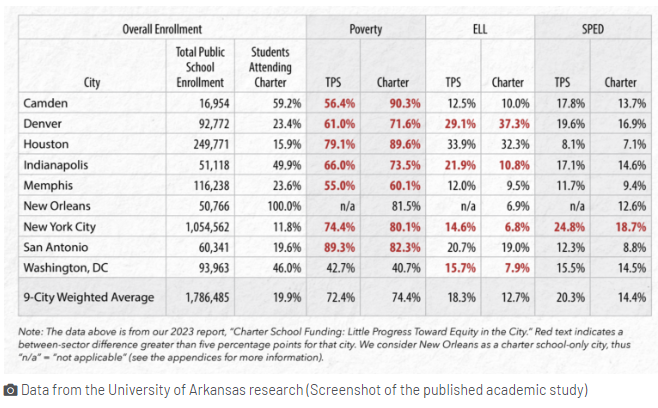
By Casey Smith
Indiana Capital Chronicle
INDIANAPOLIS — More Hoosier parents are opting to send their kids to charter schools, and new research insists that moving away from traditional public schools increases students’ likelihood to achieve academically and after graduation.
A study released last week from the University of Arkansas dives into the “cost-effectiveness and return on investment” of charter school attendance in Indianapolis and eight other U.S. communities.
Researchers said their findings show that charter schools yield more learning and more predicted lifetime earnings per education dollar spent. They emphasize, too, that charter schools tend to serve a higher percentage of students in poverty than traditional public schools.
Across the nine areas studied, the latest research found that charter schools, on average, produce higher student achievement gains per $1,000 funded than traditional schools.
The study comes on the heels of two other reports from Indiana University; one confirming that Hoosier students are increasingly leaving their traditional public schools for other options, and another which shows that nearly half of all students who left public school corporations in Fall 2022 transferred to a different public school option, like a charter school.
“Education leaders and local policymakers should pay attention to charter schools’ successful models and consider how charters make each dollar go further,” said Josh McGee, associate director of the Office for Education Policy at the University of Arkansas. “Schools are likely to face increased fiscal pressure over the coming years, so we must invest in what works for students.”
Indiana lawmakers gave charter schools major funding boosts in the new state budget after advocates ramped up lobbying efforts in the 2023 legislative session to extend more benefits to the traditional public counterparts.
But charter school critics have long argued that such schools are not obligated to serve every student in a given community — unlike those in traditional public school districts. That’s because capacity limits student enrollment.
The public charters also have private boards and are therefore not accountable to voters, opponents say.
“School choice” supporters, however, maintain that parents deserve the right to more flexibility and customization in their children’s education. Doing so requires increased access to private schools, but also public charters.
How effective are charter schools?
According to the University of Arkansas study, charter schools are approximately 41% more cost-effective and yield a 58% greater return on investment, on average, than traditional public schools.
In reading, charters average 4.4 points higher than traditional schools, making charter schools 41% more cost-effective in reading, according to the study. In math, charters average 4.7 points higher per $1,000 funded, which researchers said makes them 43% more cost effective in math.
Of the areas studied, Indianapolis had the highest cost-effectiveness advantage for charters in both reading and math.
(Story continues below)
Charter schools in Indianapolis additionally have the largest return on investment advantage, in terms of dollars, when it comes to students’ predicted lifetime earnings. Researchers estimate that the rate of return for charter schooling in Indiana’s capital city is $4.75 — or 106% higher than that of traditional public schools — meaning fewer dollars are used to achieve better outcomes.
“When it comes to outcomes for students—both in school and beyond—charter schools are a great investment,” said Patrick Wolf, a professor at the University of Arkansas’ Department of Education Reform. “If charters can achieve this success despite a significant and persistent funding gap, imagine what they could accomplish if they were funded equitably.”
While the University of Arkansas report suggests that charter schools operate more efficiently, the study does not formally examine why this might be the case.
Researchers suggested part of the cause could be attributed to charter schools not having the same kind of “structural inefficiencies” as traditional public schools.
They also said that charter schools might be “nimbler” in responding to enrollment changes, while traditional public schools face higher fixed costs.
Even so, researchers emphasized that part of the mechanism which allows charter schools to produce better outcomes with less funding could be related to the fact that charter schools are exempt from some restrictions placed on public schools, “which may allow them to customize the way they spend their dollars to be more efficient and achieve better outcomes for students.”
Where Indiana’s K-12 students are going
New appropriations for charter schools were part of a $1.487 billion increase in tuition support for schools of all types approved during the most recent legislative session. Much of that was shadowed, though, as Republican legislators touted new dollars to fund a nearly universal expansion of the state’s Choice Scholarship voucher program.
Charter schools, specifically, are set to see about the same tuition support increase as traditional public schools.
New IU reports show that as more state dollars are directed towards charters a greater number of Hoosier students are opting for non-traditional public and non-public schools.
One of the recent IU studies focused on enrollment trends over the last 16 years — capturing the time period when the vast majority of Indiana’s “school choice” programs came about. Data analyzed by researchers comes from the Indiana Department of Education.
The IU analysis found that 70% of Indiana’s 286 traditional public school corporations saw the number of students enrolled decline from 2006-2022. The greatest student losses were found in urban school districts.
Indianapolis Public Schools lost 15,527 students in the past 16 years — more than any other district in the state — equal to roughly 41% of its student body.
Gary and South Bend school districts have also recorded significant drops in enrollment.
Enrollment in Gary Community Schools dropped by 73% in the past 16 years, marking the highest percentage lost by any Hoosier school district.
Union School Corporation and Clarksville Community School Corporation — both of which have started online schools — have had the highest enrollment increases.
Union saw a 1,420% change in enrollment growth in the last 16 years, according to state data. Clarksville recorded a 167% enrollment growth.
Another IU study indicates that more students, overall, transfer schools using the state’s Choice Scholarship voucher program — which allows families to receive vouchers to attend private schools.
Nonpublic schools received just over half of student transfers in recent years via the Choice Scholarship Program, and 47% of the students who left public school corporations in Fall 2022 transferred to charters or other non-traditional public schools.
University researchers noted that part of the reason for changing enrollment “is the institutional environment that allows student transfers and competition introduced by school choice reforms.” They also said online schools “appear to have been significant in boosting enrollment of school corporations.”
The state education department is expected to release statewide K-12 enrollment numbers for Fall 2023 later this month.
Changing where the money goes
A loss of student enrollment at traditional public schools means a loss of state funding. Some education advocates and state lawmakers have maintained that leaves fewer resources for traditional public school districts to spend on students, decreasing the quality of education.
Until this academic year, Indiana’s school finance system used state tax dollars to provide comparable per-pupil funding to district and charter schools.
Traditional public school districts could also levy local property taxes to pay off debt and for their operations funds. But charter schools couldn’t, putting them at a disadvantage for paying for certain expenses, like transportation or facilities costs.
Under the new state budget requiring operations sharing, school corporations are estimated to lose $9.3 million to charter schools in 2025, and another $12.5 million in 2026, according to a legislative fiscal analysis. Over time, as levies increase, the amount school corporations transfer to charter schools will increase more.
The state additionally increased the extra money given to charter schools to compensate for their lack of property taxes from $1,250 per student up to $1,400.
Bumping that amount up is expected to increase charter school revenue by an estimated $4.5 million — up to $6.0 million — in both the 2024 and 2025 fiscal years.
In addition, a Republican-backed measure approved earlier this year will force school districts in four Indiana counties to also share referendum funding with charters.
Districts in Marion, Lake, Vanderburgh and St. Joseph counties must funnel a portion of property tax operations funding growth to charter schools.
The School City of Hammond is the only district in Tuesday’s November election to qualify for the provision since it went into effect in May. Hammond has agreed to share revenue, as required by law, with 10 charter schools. The district is asking voters to extend a previously approved tax rate increase to generate $14.6 million in operational funds for each of the next eight years.





